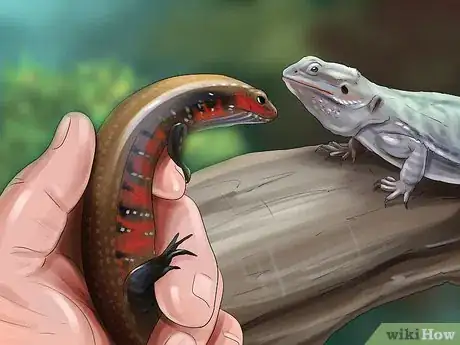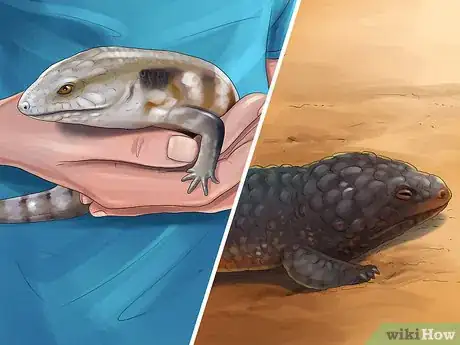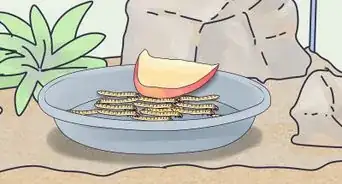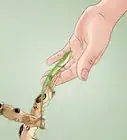This article was co-authored by Alisa Rassin. Alias Rassin is an Exotics Veterinarian and the Owner of The Exotic Animal Hospital of Pennsylvania in Lansdowne, Pennsylvania. With over a decade of experience, she specializes in treating reptiles, birds, and small mammals. She holds a Veterinariae Medicinae Doctoris from The University of Pennsylvania and a BS in Veterinary Biomedical and Clinical Sciences from Penn State University. She was also certified by the Royal College of Veterinary Surgeons.
wikiHow marks an article as reader-approved once it receives enough positive feedback. This article received 24 testimonials and 90% of readers who voted found it helpful, earning it our reader-approved status.
This article has been viewed 334,774 times.
Skinks are medium-sized reptiles many enjoy keeping as pets. A skink can be an excellent pet with proper care. Make sure your skink has a comfortable tank with plenty of space to roam and hide. Provide a diet rich in the nutrients a skink needs to thrive. Take care when interacting with your skink. As long as they're handled with respect, skinks can be very social.
Steps
Providing Proper Shelter
-
1Get the right size tank for your skink. Bigger is better when it comes to a skink's tank. Skinks need lots of room to roam to be healthy and happy. Hatchlings can be comfortable in a 10 to 20 gallon (37.9 to 75.7 L) tank. If you have a larger skink, make sure the tank is at least 30 to 40 gallons (110 to 150 L). If you have the space or money for a bigger tank, it's always nice for a skink to have extra room to roam.[1]
-
2Fill the tank with substrate. Substrate is the substance used to fill the bottom of a tank. It's important to use a substrate that's comfortable for your skink. At least 6 inches (15.2 cm) of a quality substrate is necessary for your skink.[2]
- A mixture of soil, sand, and wood chips is usually a good option. If you have a pet store near you that sells reptiles, you may be able to find a substrate specifically for skinks there.
- Make sure to keep the substrate damp. The substrate should not be soaking wet, but it should have some moisture. Skinks require a somewhat humid environment.
Advertisement -
3Keep the tank at the right temperature. Skinks require both a warm and cool end of their tank. Reptiles keep their bodies warm and cold by shifting between two different environments.[3]
- One area of the tank should be slightly above room temperature. A few UV lightbulbs near the cooler end of the tank should keep it warm enough. Make sure not to place the tank anywhere in your house where it gets very cold or very hot during certain times of the day.
- Another area should be around 90 degrees. You can get an under tank heating device, which you can purchase at a pet store. You can also use an overhead heating lamp. If you use both, turn the heating lamp off at night.
-
4Maintain adequate humidity. The tank does not need to be extremely humid, and does not require regular misting like other reptile tanks. Damp substrate should keep the tank humid, but you also need to provide your skink with a water bowl. Get a shallow water bowl for the tank big enough for your skink to lie down in.[4]
-
5Give your skink plenty of space to dig and hide. Skinks will get bored or anxious if they don't have hiding spaces in their tank. Stop by your local pet store and get things like hidey holes and other enclosures. Place these around the tank so your skink can have a hiding place when it wants privacy.[5]
- Make sure your substrate remains six inches deep. This will allow your skink to hide when it wants to.
Feeding Your Skink
-
1Feed your skink a diet of insects. Skinks primarily eat insects. You can buy insects at a pet store. If there's not a pet store near you that caters to reptiles, you can see if you can purchase insects online.[6]
- Feeder insects and crickets should be the main staple of your skink's diet. King worms and mealworms are appropriate to feed to your skink on occasion.
- Make sure prey is live. Skinks will not eat insects they do not have to stalk.
-
2Supplement your skink's diet with fruits and vegetables. In addition to eating insects, skinks enjoy a variety of fruits and vegetables. This can help supplement your skink's diet by adding some extra nutrients.[7]
- Brussels sprouts, carrots, greens, and peas are good vegetables to serve your skink.
- Fruits that skinks enjoy include blueberries, mangos, raspberries, papayas, cantaloupes, strawberries, and figs.
-
3Avoid certain products. Always read nutritional information before feeding your skink. Skinks should not be fed food that's treated with pesticides. You should also avoid giving your skink any food with artificial coloring. Foods that contain by-products, like chicken and and meat/bone meal, should not be given to a skink.[8]
-
4Replace your skinks' water each day. Skinks tend to get a lot of sand and debris in their water. You should have a water bowl in your skink's cage that cannot easily tip over. As it will get contaminated frequently, replace the water in this bowl each day.[9]
Socializing Your Skink
-
1Avoid cage mates in general. For the most part, skinks will not do well with a cage mate. Stick to one skink per tank. Skinks tend to be territorial. If you introduce a cage mate, one or both skinks may end up with bite marks or missing limbs.[10]
-
2Introduce tank mates only if they're a similar size. If you have your heart set on a second skink, exercise extreme caution. Make sure the tank mate is the same size as your current skink. Skinks will attack smaller skinks.
- If the skinks begin fighting, you should resign yourself to keeping them in separate cages.
- If you have a fire skink, these tend to be very territorial. It's a bad idea to introduce a cage mate.
-
3Handle your skink with care. Skinks can learn to be social, but proper handling is required. When handling your skink, make sure to treat it with respect. Improper handling can cause your skink to bite and become aggressive.[11]
- Never handle a skink when it's not expecting it. Do not pick up a sleeping skink. Make sure the skink knows you're there before you attempt to pet it or pick it up.
- Make sure to support a skink's body weight when holding it.
- Do not turn a skink upside down. This causes distress.
- Avoid any abrupt movements when handling a skink.
-
4Make sure children know how to safely handle a skink. Talk to children about the proper rules for handling a skink. Make sure they understand to handle the skinks with care, and not to do anything that could frighten them. You may want to avoid letting very young children handle a skink, as they may not understand how to control themselves around an animal.[12]
Expert Q&A
-
QuestionHow do you keep a blue-tailed skink as a pet?
 Alisa RassinAlias Rassin is an Exotics Veterinarian and the Owner of The Exotic Animal Hospital of Pennsylvania in Lansdowne, Pennsylvania. With over a decade of experience, she specializes in treating reptiles, birds, and small mammals. She holds a Veterinariae Medicinae Doctoris from The University of Pennsylvania and a BS in Veterinary Biomedical and Clinical Sciences from Penn State University. She was also certified by the Royal College of Veterinary Surgeons.
Alisa RassinAlias Rassin is an Exotics Veterinarian and the Owner of The Exotic Animal Hospital of Pennsylvania in Lansdowne, Pennsylvania. With over a decade of experience, she specializes in treating reptiles, birds, and small mammals. She holds a Veterinariae Medicinae Doctoris from The University of Pennsylvania and a BS in Veterinary Biomedical and Clinical Sciences from Penn State University. She was also certified by the Royal College of Veterinary Surgeons.
Exotics Veterinarian Make sure that they live in a humid environment with a good basking lamp and not too much stuff on the bottom of their enclosure. In terms of food, feed them small- and medium-sized roaches that you've fed on a good veggie diet (like dark leafy greens and carrots). That way, the roaches will be loaded up with all the vitamins and minerals that your skink needs.
Make sure that they live in a humid environment with a good basking lamp and not too much stuff on the bottom of their enclosure. In terms of food, feed them small- and medium-sized roaches that you've fed on a good veggie diet (like dark leafy greens and carrots). That way, the roaches will be loaded up with all the vitamins and minerals that your skink needs.
Warnings
- The skink is sometimes very defensive of himself and his territory. If he feels threatened or if you pick him up the wrong way, he will bite. If he does bite, wash your hands immediately.⧼thumbs_response⧽
Expert Interview

Thanks for reading our article! If you'd like to learn more about caring for skinks, check out our in-depth interview with Alisa Rassin.
References
- ↑ http://www.reptilesncritters.com/care-guide-fire-skink.php
- ↑ http://www.reptilesncritters.com/care-guide-fire-skink.php
- ↑ http://www.reptilesmagazine.com/Care-Sheets/Lizards/Blue-Tongue-Skink/
- ↑ http://www.reptilesncritters.com/care-guide-fire-skink.php
- ↑ http://www.reptileexpert.co.uk/keepingskinksaspets.html
- ↑ http://www.reptilesncritters.com/care-guide-fire-skink.php
- ↑ http://www.reptilesmagazine.com/Care-Sheets/Lizards/Blue-Tongue-Skink/
- ↑ http://www.reptilesmagazine.com/Care-Sheets/Lizards/Blue-Tongue-Skink/
- ↑ http://www.reptileexpert.co.uk/keepingskinksaspets.html
About This Article
To care for a skink, feed your skink live insects like crickets or feeder insects, because skinks won't eat dead ones. As an occasional treat, give it king worms or mealworms. To supplement its diet, give it fruits and vegetables, such as carrots, greens, or peas. However, you should avoid giving your skink any food that contains pesticides or artificial coloring as these products are harmful to skinks. Since skinks often get debris in their water, make sure to replace its water daily. For tips on how to handle your skink and how to introduce it to other skinks, keep reading!












































































